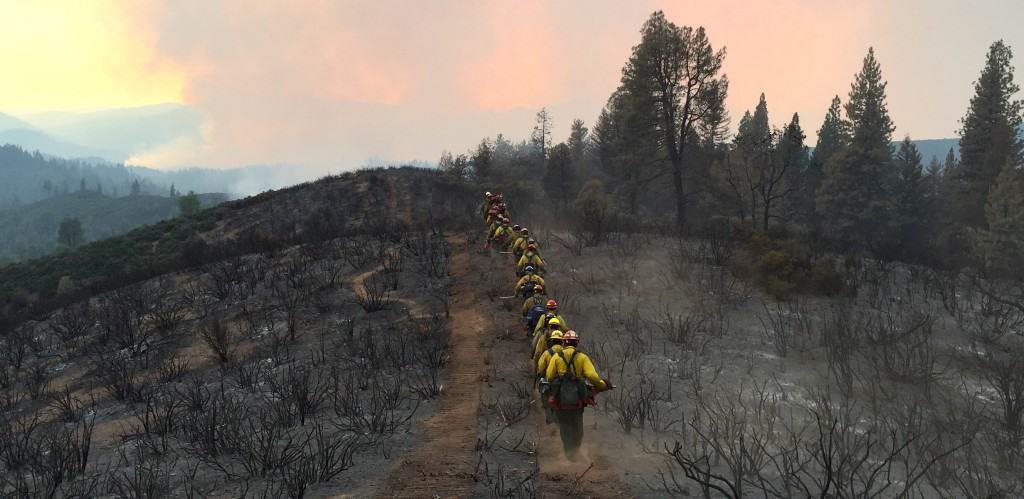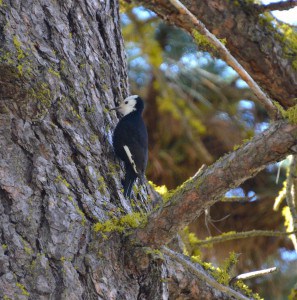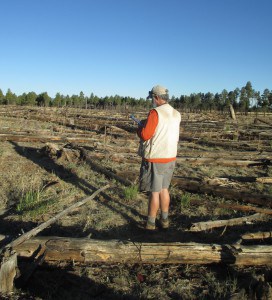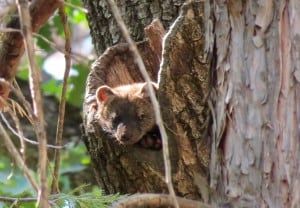Share this article
Wildfire!
Toward Understanding Its Effects on Wildlife — from The Wildlife Professional
There are few places in western North America, and increasingly in the northern regions of Canada and Alaska, where wildfire and its effects are unfamiliar sights. Last year, wildfires burned more than 800,000 hectares of National Forest lands; the same year, a record 4.1 million hectares burned across all land ownerships in the United States. National Forest lands have been particularly hard-hit in the five-year span from 2011 to 2015, with over 3.6 million ha scorched. Not surprisingly, given the horrific images that emerge from these fires, the public’s view of wildfires is strongly negative, and most people generally support efforts to reduce the risks of large, severe fires. At the same time, the public is less familiar with the positive aspects of wildfire, such as the creation of wildlife habitat or the maintenance of ecological processes upon which many desirable ecosystem services depend.
However, wildlife professionals know, many North American ecosystems are fire-adapted and require fire to shape their structures, functions and processes, which in turn shape wildlife habitats and populations in important ways. Over the past century, however, synergistic effects of fire exclusion, livestock grazing, timber harvest and land development have led to conditions where many wildfires are larger and burn with greater intensity and severity than they did in the past.
No doubt, the emerging influences of climate change are now resulting in longer burning seasons and a greater land base that is susceptible to wildfire.
Drought and hotter temperatures also lead to increases in insect outbreaks that add to fuel loads across the landscape.
The U.S. Forest Service is working to better understand effects on wildlife habitats and populations and also to understand effects of fuel reduction treatments aimed at reducing risk of uncharacteristic fire. These management practices aim to reduce the probability of uncharacteristic, high-intensity, stand-replacing events and allow fire to provide a diversity of landscape conditions as it has done for millennia.
Changes in Fire Management Practices
Today, the structure and composition of many fire-adapted, low- to mid-elevation forests across western North America deviate substantially from historical conditions as the result of fire suppression and other management actions. For example, tree densities and fuel loads are generally greater, and the array of vegetative conditions differs from those existing prior to fire suppression. This structural simplification promotes more uniform, large-scale disturbances, which in turn result in larger patches of uniform habitat.
Land managers use both forest thinning and prescribed fire — individually and in combination — to break the cycle of large-scale fires by reducing fuel loads and fire risk as well as to restore the structure, function and processes of forested ecosystems. Some species may be negatively impacted in the short term while others may benefit over time as a more resilient community is restored.

At 894,552 hectares, Shasta-Trinity National
Forest in Northern California is the largest in the state. Here a multi-agency hand crew from Alabama and Georgia National Forests head out to build firebreaks in the Fork Complex during a wildfire in August 2015. ©Micah Thorning, USFS
Effects on Small Mammals and Birds
To better understand the impacts on wildlife, the national Fire and Fire Surrogates Study conducted an integrated network of experiments at 13 sites across the United States (Schwilk et al. 2009), many of which took place on National Forest lands.
The results suggest that more species increased in number than decreased. For example, researchers reported that populations of western bluebirds (Sialia mexicana) increased following prescribed fire; whereas mountain chickadees (Poecile gambeli) decreased in response to thinning treatments (Hurteau et al. 2008). The positive and negative responses of deer mice (Peromyscus maniculatus), gray-collared chipmunks (Tamias cinereicollis) and least chipmunks (T. minimus) varied among the sites; but the overall biomass of small mammals increased in response to the fire treatments (Converse et al. 2006). Researchers also found that small mammals’ responses were related to fire uniformity: the more heterogeneous the post-fire landscape, the greater the proportion of positive responses.
Another regional effort, The Birds and Burns Network, evaluated the effects of different fire conditions — including unburned and prescribed and wildland fires — on populations and habitats of birds throughout the West (Saab et al. 2007). This study was replicated at 10 locations dominated by ponderosa pine, extending from the middle Rockies to the Southwest. In the northern sites, prescribed fire treatments resulted in increased occupancy rates for many bark-insectivore, cavity-nesting, aerial-insectivore and ground-insectivore species; whereas some foliage insectivores and seed specialists declined following treatments. In the Southwest, the impacts of prescribed fire treatment on breeding birds were minor. Collectively, the results of these studies suggest that two to three years after a prescribed fire, more species benefitted than not.
Studies from the Birds and Burns Network also analyzed relationships of bird occupancy with the severity of wildfires in dry pine forests in Idaho and Arizona — states that have historically different fire regimes. Proportionately more positive species occupancy relationships were observed for mixed-severity fire regimes. In Idaho, researchers observed a positive species richness relationship with burn severity, while they observed the opposite pattern in Arizona, which fits with the low-severity fire regime characterizing the state.
Overall, cavity nesters and aerial insectivores occupied more severely burned sites following wildfire, corresponding with predicted increases in nesting substrate and foraging opportunities for these species. In contrast, canopy-nesting foliage gleaners and pine-seed consumers exhibited negative relationships with burn severity. Results like these are useful for creating optimal regional management strategies for maintaining avian diversity. Specifically, intensive fuels management may be ecologically less appropriate for promoting biodiversity in areas where mixed-severity wildfires and dense forest stands were historically more common.
The Special Case of Woodpeckers

A white-headed woodpecker forages in open ponderosa pine forest in Washington’s Okanogan-Wenatchee National Forest. As cavity nesters, populations of this woodpecker species and others are strongly influenced by fire and timber management activities. ©Peter Singleton
Wildland fire creates many standing dead trees that provide habitat for disturbance-associated species, notably black-backed (Picoides arcticus), Lewis’ (Melanerpes lewis), and white-headed woodpeckers
(P. albolarvatus). In fact, these and several other species of cavity-nesting birds are considered species of conservation concern by state and federal agencies because the birds’ populations are strongly influenced by fire and timber management activities (Saab et al. 2007).
Wildlife managers worry that certain timber management practices such as removal of snags in post-fire logging operations have the potential to decrease regional woodpecker populations. The Forest Service is assessing locations and prescriptions for post-fire timber harvest such that negative impacts to woodpeckers are minimized.
Saving the Spotted Owl
The northern spotted owl (S. occidentalis caurina), a federally threatened species, was listed in 1990 largely due to concerns about loss of habitat in the Northwest resulting from commercial timber harvest. But balancing forest management objectives focused on reducing the risk of high-severity wildfire with conservation of old forest habitat is a particular challenge for land managers.
Much of the southern and eastern portions of the owls’ range historically supported low- and mixed-severity fire regimes. However, today, wildfire has become the leading cause of habitat loss on federal lands, though the relative effects of fire and timber harvest vary by land ownership, ecoregion, and fire regime (Davis et al. 2011). These areas have experienced significant increases in stand density and loss of large trees during the 20th century, increasing the probability of large fires and insect outbreaks that could further disturb the spotted owls’ habitat.
Research shows that the effects of wildfire interact in complex ways with the creation, maintenance and destruction of northern spotted owl habitat. While large-scale, high-severity wildfires pose substantial risks to owl habitat, fires of low-, moderate- and mixed-severity may also contribute to the spatial and structural complexity characteristic of areas currently occupied by spotted owls in fire-prone landscapes (Clark et al. 2013). Size, severity and pattern of fire impacts all appear to be important factors that can contribute to variable spotted owl site persistence after fires (Clark et al. 2013). Similar patterns have also been reported for the California (S. occidentalis occidentalis) and Mexican spotted owl (S. occidentalis lucida) subspecies (Lee and Bond 2015).
Overall, these studies suggest that spotted owls can persist with some level of natural disturbance in fire-prone landscapes provided that adequate nesting and roosting characteristics are retained and abundant prey resources are available in suitable foraging areas after the disturbance. In a review of the literature on the effects of forest fragmentation on all three subspecies of spotted owls, the authors concluded that at the territory scale, some degree of forest heterogeneity — including early seral patches and ecotones — may contribute to owl habitat (Franklin and Gutierez 2002). However, it is also important to note that the long-term effects of wildfire on northern spotted owl habitat and site occupancy are not well documented. Current forest patterns and fuel loads have created conditions susceptible to large-scale, high-intensity wildfires that can substantially simplify forest structure and landscape patterns across relatively broad areas, eliminating nesting and roosting habitat characteristics required for northern spotted owl post-disturbance site persistence. New silvicultural approaches that integrate fuel reduction and spotted owl habitat conservation objectives are being developed and tested in Forest Restoration Projects on NFS lands across fire-prone portions of the range of the northern spotted owl (Lehmkuhl et al. 2015).
Fires Help Fisher Populations
Many forest carnivores, including the fisher (Pekania pennanti), are also associated with the complex forest structure found in older or late-successional forest. Structural attributes such as closed canopy, dense understory and multi-layer stands have frequently been identified as important habitat features, providing secure resting and denning sites as well as access to a diverse prey base (Aubrey et al. 2013). However these same characteristics, when prevalent across the landscape, have the potential to promote the spread of the large, severe wildfires. These fires not only destroy the necessary structural elements for foraging and reproduction, they also fragment the available habitat and limit genetic flow between isolated subpopulations.

Bill Block, wildlife program leader for the Rocky Mountain Research Station conducts bird point-counts 17 years following the 1996 Horseshoe/Hochderffer fires in Arizona’s Coconino National Forest. The study aims to evaluate long-term effects of wildfire on bird community structure in ponderosa pine forests of northern Arizona. ©Jean Block
Recent evidence suggests that fishers are not only capable of using post-, low-to-moderate fire landscapes, but that these fires can also help create a new generation of denning and resting sites as well as protect the integrity of the overall landscape mosaic (Spencer et al. 2011). In contrast, disturbances that simplify stands and landscapes can remove critical habitat elements and have long-term detrimental impacts.
But little information is available on the direct impacts of wildfire on fisher survival, reproduction and occupancy. A growing body of evidence suggests that the species tolerates low-to-moderate levels of habitat disturbance as long as thresholds of scale and intensity are not exceeded. In one study, researchers found that fishers did not avoid disturbances at the home range scale, as long as disturbed patches, characterized by reduced structural complexity, were sufficiently dispersed such that animals could move around them (Zielinski 2013). Surveys of post-fire landscapes using scat-detector dogs also have found evidence of fisher activity one year (C. Thompson unpublished data) and 12 years later (Hanson 2015). These data are currently being used to not only promote the conservation and restoration of forest carnivore habitat in the Sierra Nevada region, but to help guide forest management.
Protecting the Future

A female fisher peers from a den cavity in a California black oak on the Sierra National Forest, Calif. Recently burned forests are not conducive to fisher reproduction, and males and dispersing juveniles only explore the areas occasionally. ©Craig Thompson
As the trend toward more and larger fires increases, the decisions made now in the early part of the 21st century will set the stage for how these landscapes support wildlife populations for hundreds of years to come. Working with partners, USFS programs restored or enhanced more than 2.6 million hectares of public and private forest lands in 2014, making them more resilient to the effects of wildfire. But approximately 25-34 million hectares are still in need of management to increase resilience.
Many of these ongoing projects are intended to emulate the influence of fire in creating spatial heterogeneity in vegetation and fuel conditions. Increased vegetative heterogeneity — including the retention and development of important habitat conditions such as a mosaic of large, mature trees and open patches of early-seral conditions — promotes a diverse wildlife community while also providing a more fire-resilient landscape for future generations.
 |
Brian Logan, MS, is the national wildlife program leader for the U.S. Forest Service in Washington, D.C. and a past president of the TWS Montana State Chapter. |
| Peter Singleton, PhD, is a research wildlife biologist at the USFS Pacific Northwest Research Station and a past-president of the TWS Washington State Chapter. |
| Craig Thompson, PhD, is a research wildlife ecologist at the USFS Pacific Southwest Research Station. |
| Victoria Saab, PhD, is a research wildlife biologist at the USFS Rocky Mountain Research Station. |
| William Block, PhD, is a program manager at the USFS Rocky Mountain Research Station, Caesar Kleberg Award recipient, TWS Fellow, and former editor-in-chief of the Journal of Wildlife Management. |
Header Image: Spurred on by strong winds and low humidity, the high-intensity 2011 Wallow Fire in the Arizona’s Apache- Sitgreaves National Forest burns toward vulnerable communities. In total, 217,833 hectares were singed in this fire. ©USFS








